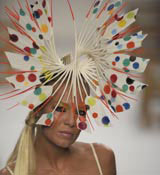Designers for life
In 30/30 Vision, the Crafts Council is celebrating 30 years of kick-starting careers in crafts design – and about time too, says Pamela Buxton

After 30 years of quietly handing out invaluable Setting-Up grants to promising, but often financially-stretched makers, the Crafts Council could be forgiven for patting itself on the back with its latest exhibition, 30/30 Vision, featuring the work of 30 of the 1200-plus recipients.
But this is no worthy-but-dull presentation. Instead, this hugely enjoyable show is an inspiring celebration of talented individuals from across the crafts spectrum. Simply, but effectively designed by Gitta Gschwendtner (fittingly herself a grant recipient), it not only raises awareness of the diverse nature of crafts far away from the ‘country crafts’ cliché, but throws light on the varied career paths the winners have followed since receiving their grants. And judging by this show, the creative journey is rarely smooth, straight or boring.
The Crafts Council has evidently backed a lot of winners – and an impressive 90 per cent are still in business after a decade. It’s certainly hard to think of anything else that could have linked such diverse success stories as Habitat creative director Tom Dixon, architectural glass artist Alexander Beleschenko, conceptual jeweller Mah Rana, ceramics star Bodo Sperlein and calligrapher Gary Breeze – with those of nearly 1300 other designers and makers who’ve all benefited from the grant down the years.
Visually, with such a range of objects and scale (anything from a ring to a massive piece of architectural glasswork) it could have been a bit of a hotchpotch. But the exhibition design provides an underlying visual link. Gschwendtner came up with a display system in the form of a giant tape measure, which measures careers rather than centimetres.
Each exhibitor has their own length of it, undulating up and down along the floor or up the wall to form display mats, tables and spaces of different length.
The work is displayed along it at the appropriate point – the markings indicate dates of birth, training, award of grant plus significant milestones along the individual’s career. The tape also serves as a clever way of dealing with the difficult corridor linking the two galleries – Gschwendtner uses these walls to display all the names of the recipients year by year so that everyone gets a name-check.
30/30 Vision is enjoyable enough on face value because of the quality of the work – Kei Ito’s gorgeous sculptural bags (pictured below) and garments and Carl Clerkin’s quirky upholstered seating are particularly memorable. Closer inspection of the different career paths rewards as well, revealing those where makers have gone in different directions: Jane Atfield has diversified into printed textiles after success with her trademark recycled furniture, while Dai Rees has moved away from the fashion world where he made his name as accessory-maker-to-the-catwalk (pictured above). His latest, disconcerting piece, is a leather installation documenting the Iraq war.
These stories are enhanced by the arrangement of exhibitors in pairs to draw attention to certain parallels – Tom Dixon and the Azumis, for example, have both made the difficult transition to designing for industry rather than working in batch production or as a designer-maker.
Or the link may be discipline – Breeze and Brody Neunenschwander share a passion for calligraphy, but work in completely different ways, Breeze as a letter-cutter and Neunenschwander as a calligraphic artist working on films such as Peter Greenaway’s The Pillow Book and Prospero’s Books.
30/30 Vision is a fitting tribute to both the exhibitors’ talents and to the grant scheme itself, now relaunched as the Crafts Council Development Award and still on the look out for new talent to nurture.
30/30 Vision – Creative Journeys in Contemporary Craft shows until 1 June at the Crafts Council, 44a Pentonville Road, London N1
-
Post a comment




